Reduce the Risk Associated with Time Value Decay

Reduce the risk associated with time value decay
In this article, we will examine how to reduce the risk associated with the time value decay of options in a directional position, as well as how this affects the strategy’s payoff profile.
As can be seen in the following chart, the price of shares in BCE Inc. (BCE) have reached a resistance level at $65 for a third time since last October, while the RSI and the Stochastic oscillator are in overbought territory. Let us say that you believe that BCE will now start falling, reaching $62.50 over the next few weeks. Such a loss would represent just over 2.8% from BCE’s closing price of $64.33 on February 14, 2020.
Chart 1: Daily Price Changes for BCE to February 14, 2020 ($64.33)
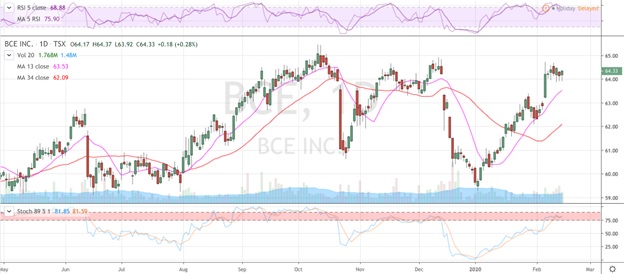
The table below provides data on BCE $64.50 and $63.00 put options expiring on March 13, 2020, as of February 14, 2020.
Table 1: Data on $64.50 and $63.00 Put Options Expiring March 13, 2020, as of February 14, 2020
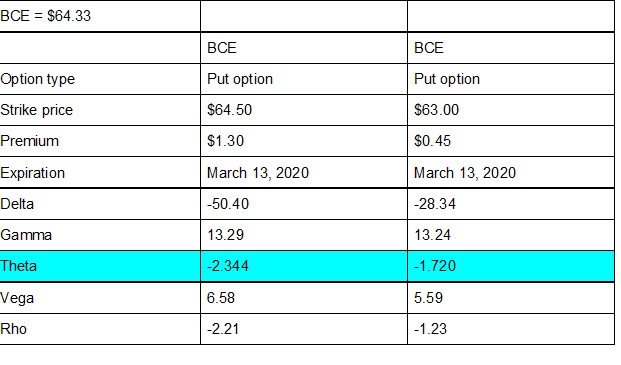
Let us begin by analyzing the purchase of the BCE $64.50 put options expiring on March 13, 2020 (BCE200313P64.50), priced at $1.30. As shown in Chart 2 below, if the shares reach the target price of $62.50 when the options expire we will realize a profit of $70 per contract ($0.70 per share), for a return of 53.85%. At that time, the value of the BCE200313P64.50 put options will be $2.00 ($64.50 – $62.50). The $0.70 profit per share is obtained by taking the $2.00 target value of the options minus the purchase price of $1.30. The return is obtained by dividing the $0.70 profit by the initial price of $1.30.
Chart 2: Profit and Loss Diagram for $64.50 Put Options Expiring on March 13, 2020
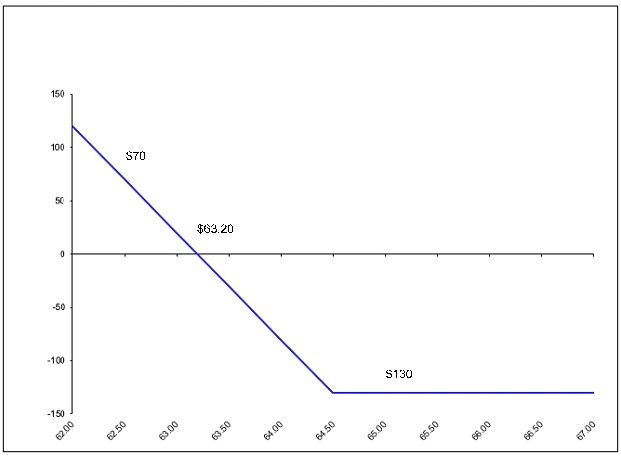
The $63.20 breakeven price is obtained by subtracting the $1.30 premium from the $64.50 strike price. The maximum loss of $130 will be realized if the price of BCE is greater than or equal to $64.50 when the options expire on March 13, 2020.
As can be seen in Table 1 above, theta, which measures the decay per day of the option premium, is -2.344 per contract or -0.02344 per share, for a loss of 2.344 cents per day. So, everything else being equal, we can expect the premium on the put to decline to $1.07 in ten days (1.30 – [0.02344 × 10]). For the purposes of this article, we would like to reduce the negative impact of time value decay on our put options. To achieve this we will convert our position into a bear spread by selling put options with the same expiry, but with a lower strike.
We will choose[1] BCE $63.00 put options expiring on March 13, 2020, at $0.45 per share. As shown in Table 1 above, the theta of this option is -1.720 per contract or -0.0172 per share. So, everything else being equal, we can expect the premium for this option to decline by 1.72 cents per share per day, or 17.2 cents per share after ten days. Since we want to take advantage of this loss in value, we need to be the seller of this option. This means that theta, which is negative for the option holder, will become positive for our position because we are now the writers (sellers).
Table 2: Data on a $64.50/$63.00 Bear Spread Expiring March 13, 2020, as of February 14, 2020
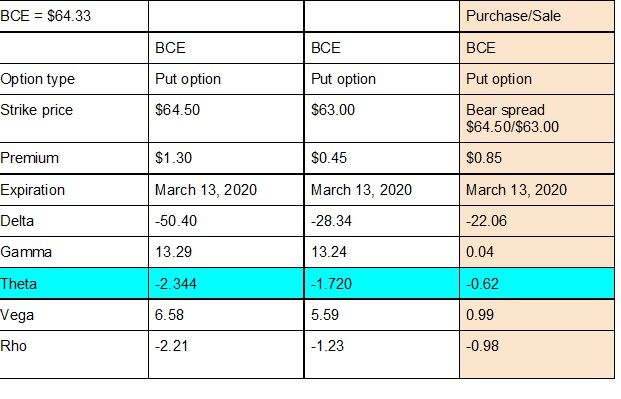
Table 2 above presents the data for the $64.50/$63.00 bear put spread expiring on March 13, 2020, as of February 14, 2020. As you can see, the position’s theta has been reduced to a loss of 0.62 per contract (0.062 per share). This is a 73.5% improvement.
The profit and loss profile of the position, now a bear spread, will change as follows.
Chart 3: Profit and Loss Diagram of the $64.50/$63.00 Bear Spread Expiring March 13, 2020
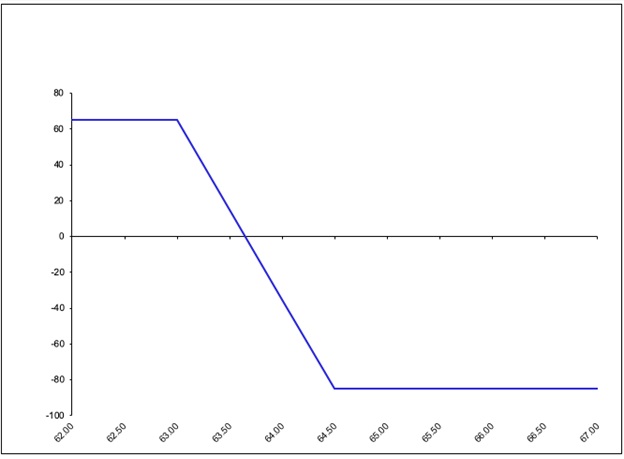
As can be seen in Chart 3 above, the profit and loss profile of the bear spread differs from that of the initial long position: our profit is now limited to $65 per contract ($0.65 per share) vs. $70 if BCE falls below $63, and the maximum loss is reduced to $85 per contract ($0.85 per share) vs. $130 if BCE closes at a price equal to or greater than $64.50 on March 13, 2020. The breakeven price of $63.65 vs. $63.20 is obtained by subtracting the maximum loss of $0.85 per share from the $64.50 strike. The maximum potential return is now 76.5% (0.65 ÷ 0.85). This represents a significant improvement over the previous return of 53.85% (0.70 ÷ 1.30).
In conclusion, by adding the sale of the $63.00 put options expiring on March 13, 2020, to our long position on the $64.50 put options with the same expiration, we were able to implement a strategy that reduced the impact of the contract’s daily time value decay, from $2.34 per contract to $0.62 per contract. At the same time, we improved our overall performance profile (based on the target price of $62.50) from 53.85% to 76.50%, although the maximum profit was reduced from $70 to $65 per contract. This is because we were able to reduce the maximum loss from $130 to $85 per contract. In so doing, we also improved our breakeven price, from $63.20 to $63.65. It should be noted, however, that these results are based on a target price of $62.50 on BCE, and a different target could substantially change the profit and loss diagram.
Good luck with your trading, and have a good week!
The strategies presented in this blog are for information and training purposes only, and should not be interpreted as recommendations to buy or sell any security. As always, you should ensure that you are comfortable with the proposed scenarios and ready to assume all the risks before implementing an option strategy.
[1]We chose this strike because subtracting the $0.45 premium from a $63.00 strike gives us a breakeven price of $62.55, which is very close to our target price for BCE of $62.50. A more exhaustive analysis might have led us to choose another one.
President
Monetis Financial Corporation
Martin Noël earned an MBA in Financial Services from UQÀM in 2003. That same year, he was awarded the Fellow of the Institute of Canadian Bankers and a Silver Medal for his remarkable efforts in the Professional Banking Program. Martin began his career in the derivatives field in 1983 as an options market maker for options, on the floor at the Montréal Exchange and for various brokerage firms. He later worked as an options specialist and then went on to become an independent trader. In 1996, Mr. Noël joined the Montréal Exchange as the options market manager, a role that saw him contributing to the development of the Canadian options market. In 2001, he helped found the Montréal Exchange’s Derivatives Institute, where he acted as an educational advisor. Since 2005, Martin has been an instructor at UQÀM, teaching a graduate course on derivatives. Since May 2009, he has dedicated himself full-time to his position as the president of CORPORATION FINANCIÈRE MONÉTIS, a professional trading and financial communications firm. Martin regularly assists with issues related to options at the Montréal Exchange.
The information provided on this website, including financial and economic data, quotes and any analysis or interpretation thereof, is provided solely for information purposes and shall not be construed in any jurisdiction as providing any advice or recommendation with respect to the purchase or sale of any derivative instrument, underlying security or any other financial instrument or as providing legal, accounting, tax, financial or investment advice. Bourse de Montréal Inc. recommends that you consult your own advisors in accordance with your needs before making decision to take into account your particular investment objectives, financial situation and individual needs.
All references on this website to specifications, rules and obligations concerning a product are subject to the rules, policies and procedures of Bourse de Montréal Inc. and its clearinghouse, the Canadian Derivatives Clearing Corporation, which prevail over the content of this website. Although care has been taken in the preparation of the documents published on this website, Bourse de Montréal Inc. and/or its affiliates do not guarantee the accuracy or completeness of the information published on this website and reserve the right to amend or review, at any time and without prior notice, the content of these documents. Neither Bourse de Montréal Inc. nor any of its affiliates, directors, officers, employees or agents shall be liable for any damages, losses or costs incurred as a result of any errors or omissions on this website or of the use of or reliance upon any information appearing on this website.
BAX®, CADC®, CGB®, CGF®, CGZ®, LGB®, MX®, OBX®, OGB®, OIS-MX®, ONX®, SCF®, SXA®, SXB®, SXF®, SXH®, SXM®, SXO®, SXY®, and USX® are registered trademarks of the Bourse. OBW™, OBY™, OBZ™, SXK™, SXJ™, SXU™, SXV™, Montréal Exchange and the Montréal Exchange logo are trademarks of the Bourse. All other trademarks used are the property of their respective owners.
© 2024 Bourse de Montréal Inc. All Rights Reserved.
